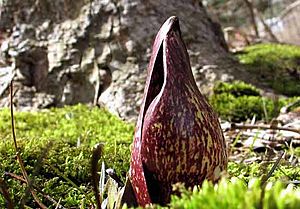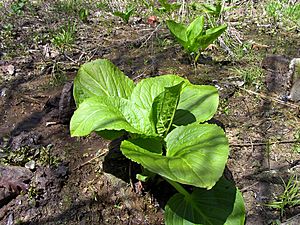Skunk cabbage facts for kids
Quick facts for kids Eastern skunk cabbage |
|
|---|---|
 |
|
| Skunk cabbage in early spring | |
| Scientific classification | |
| Genus: |
Symplocarpus
|
| Species: |
foetidus
|
| Synonyms | |
|
|
The Eastern skunk cabbage (scientific name: Symplocarpus foetidus) is a very interesting plant. It gets its common name because its leaves smell a bit like a skunk when they are crushed or torn. This plant loves to grow in wet places like wetlands and moist hillsides across eastern North America.
Contents
What Skunk Cabbage Looks Like
Eastern skunk cabbage has very large leaves. They can grow to be about 40 to 55 centimeters (16 to 22 inches) long and 30 to 40 centimeters (12 to 16 inches) wide.
This plant is one of the first to flower in spring, even when there's still snow on the ground! At first, you only see the flowers poking out of the mud. The main stem, called a rhizome, stays hidden underground. The leaves appear later, after the flowers have bloomed.
The flowers grow on a special stalk called a spadix, which is 5 to 10 centimeters (2 to 4 inches) long. This spadix is protected by a colorful leaf-like cover called a spathe. The spathe is usually 10 to 15 centimeters (4 to 6 inches) tall and has a mottled purple color. The underground rhizome can be quite thick, sometimes up to 30 centimeters (1 foot) across.
Where Skunk Cabbage Grows
The Eastern skunk cabbage is native to eastern North America. You can find it from Nova Scotia and southern Quebec in Canada, all the way west to Minnesota, and south to North Carolina and Tennessee in the United States. In Tennessee, it is considered an endangered plant, which means it's protected because it's rare there.
How Skunk Cabbage Survives
The Skunk Smell and Pollination
The strong smell of skunk cabbage, which gives it its name, is not harmful. It's actually a clever trick! This foul odor helps the plant attract its pollinators. These are insects like scavenging flies, stoneflies, and bees, which are drawn to the smell of decay. The smell in the leaves might also keep large animals from eating or damaging the plant, especially since it grows in soft, wet soil.
Making Its Own Heat
Eastern skunk cabbage is amazing because it can actually make its own heat! It can raise its temperature by 15 to 35 degrees Celsius (27 to 63 degrees Fahrenheit) above the air temperature. It does this through a special process in its cells. This heat helps the plant melt its way through frozen ground, allowing it to grow even when there's still snow and ice.
Even though it flowers in very cold conditions, it successfully gets pollinated by early insects that also come out at this time. Some scientists think that the heat not only helps the plant grow in icy soil but also helps spread its smell into the air. Insects that like the scent are even more likely to go inside the warm spathe, which helps with pollination.
Growing Downward: Contractile Roots
Skunk cabbage has special roots called contractile roots. After these roots grow into the earth, they contract or pull back. This action pulls the plant's stem deeper into the mud. So, instead of growing mostly upward like most plants, skunk cabbage actually grows downward into the earth over time! Older plants can be very hard to dig up because they are so deep.
Reproduction and Seeds
Skunk cabbage reproduces using hard, pea-sized seeds. These seeds fall into the mud and can be carried away by animals or by floods. Some types of blowflies, like Calliphora vomitoria, are known to help pollinate skunk cabbage.
Uses of Skunk Cabbage
In the 1800s, Eastern skunk cabbage was used as a medicine called "dracontium." It was used to treat breathing problems, nerve issues, rheumatism (joint pain), and dropsy (swelling).
Today, people sometimes grow skunk cabbage in water gardens because of its unique look. Native American tribes used skunk cabbage a lot. They used it as a medicinal plant, a seasoning for food, and even as a magical talisman. The young leaves, when thoroughly dried, can be added to soups or stews. The dried rootstocks can be ground into a flour that tastes a bit like cocoa.
Is Skunk Cabbage Toxic?
Skunk cabbage contains tiny crystals called calcium oxalate. Because of these crystals, the plant is considered to have medium toxicity for humans if eaten raw. However, if it is prepared very carefully, the toxicity can be removed. It's always best to be careful with wild plants.
Gallery
-
A cut-away view of the spadix (flower cluster) inside the spathe of the skunk cabbage.
-
Skunk cabbage leaves and blooming marsh marigolds (Caltha palustris) in a wooded marsh







